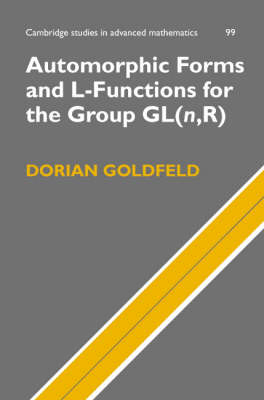
Automorphic Forms and L-Functions for the Group GL(n,R)
Seiten
2006
Cambridge University Press (Verlag)
978-0-521-83771-2 (ISBN)
Cambridge University Press (Verlag)
978-0-521-83771-2 (ISBN)
L-functions associated to automorphic forms encode all classical number theoretic information. They are akin to elementary particles in physics. This book provides an entirely self-contained introduction to the theory of L-functions in a style accessible to graduate students with basic knowledge of classical analysis, complex variable theory, and algebra.
L-functions associated to automorphic forms encode all classical number theoretic information. They are akin to elementary particles in physics. This book provides an entirely self-contained introduction to the theory of L-functions in a style accessible to graduate students with a basic knowledge of classical analysis, complex variable theory, and algebra. Also within the volume are many new results not yet found in the literature. The exposition provides complete detailed proofs of results in an easy-to-read format using many examples and without the need to know and remember many complex definitions. The main themes of the book are first worked out for GL(2,R) and GL(3,R), and then for the general case of GL(n,R). In an appendix to the book, a set of Mathematica functions is presented, designed to allow the reader to explore the theory from a computational point of view.
L-functions associated to automorphic forms encode all classical number theoretic information. They are akin to elementary particles in physics. This book provides an entirely self-contained introduction to the theory of L-functions in a style accessible to graduate students with a basic knowledge of classical analysis, complex variable theory, and algebra. Also within the volume are many new results not yet found in the literature. The exposition provides complete detailed proofs of results in an easy-to-read format using many examples and without the need to know and remember many complex definitions. The main themes of the book are first worked out for GL(2,R) and GL(3,R), and then for the general case of GL(n,R). In an appendix to the book, a set of Mathematica functions is presented, designed to allow the reader to explore the theory from a computational point of view.
Dorian Goldfeld is a Professor in the Department of Mathematics at Columbia University
Introduction; 1. Discrete group actions; 2. Invariant differential operators; 3. Automorphic forms and L-functions for SL(2,Z); 4. Existence of Maass forms; 5. Maass forms and Whittaker functions for SL(n,Z); 6. Automorphic forms and L-functions for SL(3,Z); 7. The Gelbert–Jacquet lift; 8. Bounds for L-functions and Siegel zeros; 9. The Godement–Jacquet L-function; 10. Langlands Eisenstein series; 11. Poincaré series and Kloosterman sums; 12. Rankin–Selberg convolutions; 13. Langlands conjectures; Appendix. The GL(n)pack manual; References.
| Erscheint lt. Verlag | 3.8.2006 |
|---|---|
| Reihe/Serie | Cambridge Studies in Advanced Mathematics |
| Zusatzinfo | Worked examples or Exercises; 1 Line drawings, black and white |
| Verlagsort | Cambridge |
| Sprache | englisch |
| Maße | 160 x 230 mm |
| Gewicht | 823 g |
| Themenwelt | Mathematik / Informatik ► Mathematik ► Analysis |
| Mathematik / Informatik ► Mathematik ► Arithmetik / Zahlentheorie | |
| ISBN-10 | 0-521-83771-5 / 0521837715 |
| ISBN-13 | 978-0-521-83771-2 / 9780521837712 |
| Zustand | Neuware |
| Informationen gemäß Produktsicherheitsverordnung (GPSR) | |
| Haben Sie eine Frage zum Produkt? |
Mehr entdecken
aus dem Bereich
aus dem Bereich
Buch | Softcover (2024)
De Gruyter Oldenbourg (Verlag)
59,95 €
Buch | Softcover (2024)
De Gruyter Oldenbourg (Verlag)
59,95 €


